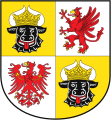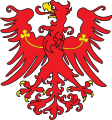Brandenburg eagle
The Brandenburg eagle , also Märkischer or Roter Adler , is the heraldic animal of the state of Brandenburg . With a partially slightly changed representation or with additional heraldic symbols, it is also part of the coats of arms of many cities and municipalities in the area of the former Mark Brandenburg .
Due to its first use by the Ascanians and as a symbol and coat of arms of the Mark Brandenburg, the eagle is also known as the Ascanian, Mark-Brandenburg or Brandenburg eagle. As a consequence of the Congress of Vienna in 1815, the province of Brandenburg was created with new borders (without the oldest part Altmark , but new with the state of Jüterbog and Niederlausitz ). The resulting new map image was interpreted as an eagle in the 19th century - almost as a happy, symbolic coincidence - with a head and beak, two wings, two fangs and a (slightly too wide) tail. Since 1945, due to the loss of the areas on the other side of the Oder, this point of view was no longer apparent; maintaining it could have been seen as revanchism . The Brandenburg eagle was also the subject of the unofficial national anthem Rise high, you red eagle.
description
The Brandenburg eagle appears in the coat of arms of Brandenburg floating freely from the front with spread wings and looking to the right. It is red, reinforced with gold and tongued with red. The fangs are open and its wings are each covered with a golden clover stem . The shield of the coat of arms is white.
Due to the historical development of the coat of arms, the eagles in the coats of arms of the municipalities, cities and states are not all alike. In some coats of arms, the eagle can only be seen half or only part of its body. Not all eagles have clover stems on their wings, but some have decorative elements on their chests. Some hold further coat of arms elements in their clutches, others are reinforced in black or red.
history
Brandenburg as a principality

The Brandenburg eagle appears for the first time in the statue of Askanier Otto I from 1170. In addition to the eagle shield, Otto I, like his father Albrecht the Bear and his son Otto II, also had shields with shield fittings, which in particular show multiple divisions. These shields were primarily the battle shields. In the ongoing battles of this time, the margraves had no point in gorgeous equipment.
There are no records of the exact origin of the Brandenburg eagle or the question of why Otto I chose this eagle. Some heraldists, such as Theodor Ilgen and Hermann Krabbo , assume that the eagle was a hereditary family symbol of the Ascanians from the pre-aldic period. The Ascanians come from the eastern slope of the Harz Mountains , and Albrecht the Bear was Count von Ballenstedt before he was made margrave ; here is the Ascanian ancestral castle. On the assumption that the eagle nestled on the mountain with the ancestral castle, it would offer itself as a suitable family symbol. This is how the eagle found its way into the coat of arms of neighboring Arnstein Castle . A use of the eagle as a family symbol before Otto I. cannot be proven.
Heraldists such as Alfred Ritter Anthony von Siegenfeld and Erich Gritzner represent another thesis . You can see the roots of the Brandenburg eagle, like the later Prussian eagle, in the plastic standard eagles and eagle flags of the German kings and emperors. The high nobility in the 12th century often carried the eagle of the empire as their official coat of arms. Until about 1180 the margraves, palatine counts, counts and burgraves were among the imperial princes. As official princes and thus representatives of the king, they carried the imperial eagle as their coat of arms and sealed with it. Some families such as the Counts of Neuenahr (line of the Are-Hochstaden), the Counts of Savoy and the Dukes of Silesia adopted the imperial eagle in its original colors, black on a yellow background, as a family symbol. When the empire dissolved at the beginning of the 13th century, the sovereigns took over all state power. For some sovereigns the imperial eagle changed its colors and became the family coat of arms, other sovereigns used their family crest again. The Ascanians also probably originally wore the black imperial eagle in yellow. In the Brandenburg line they changed the eagle to red with a yellow weir in a white field and, since Otto IV., With yellow clover stems in the wings.
Brandenburg as a province of Prussia

After the Ascanians, the red eagle remained the symbol and coat of arms of Brandenburg among the Wittelsbachers , Luxemburgers and Hohenzollerns . In 1415 it passed into the house of the Hohenzollern family. They were now the masters of the Mark. The coat of arms from 1817 and 1824 erroneously shows the royal crown, as with the Prussian eagle. In 1864 it became the strapless, Hermelin-trimmed, purple, velvety Kurhut. Kurhut, scepter and sword were granted to the eagle on April 2, 1824 and the coins were to be made with this change. From 1827 the thalers were minted in this way. By decree of January 11, 1864, the royal Prussian coat of arms from 1817 should be corrected and the eagle on the chest in memory of the arch chamberlain dignity of the dissolved Holy Roman Empire was the golden scepter in the electoral and royal coat of arms in the blue field of the eagle can be applied as a breastplate. The armament, coronation and occupation of the eagle common since 1824 were not new. As early as 1704, the shield holder showed in the free hand (i.e. outside), the Prussian eagle on the right and the Brandenburg eagle on the left in the standard. Unfortunately a mistake crept in in 1824. But known since 1804, it had no consequences. For reasons of space, the flags were fluttered inward, as in the majesty seal of Frederick II and his successors. The eagle was turned to see the flagpole. It is heraldically his reflection. So he holds the sword with his claw, which is close to the flagpole. The outer claw (catch) holds the scepter. In 1804 the flags were turned outwards again. The eagle looks at the flagpole again. The sword and scepter were swapped and so he became left-handed (the sword on the left). According to the representation of 1704, he was wrongly armed.
The Brandenburg eagles and eagle shields in the coats of arms of the cities and municipalities do not indicate their geographical location in the Mark Brandenburg, but refer to the margraves as city founders and lords. Some cities only had the eagle or the eagle in the shield as a seal, see coat of arms of Potsdam and Cölln . To distinguish themselves from the regalia of the sovereigns, many cities put the popular city wall with gate and towers in their seal. The eagle, again with and without a shield, was placed in the open city gate, hovered over the city wall or the wall was covered with its shield, see the coats of arms of Frankfurt (Oder) , Angermünde or Spandau . In the second half of the 13th century, various cities wanted their own seal or coat of arms to symbolize the city alone. Typical coats of arms for this are the talking coats of arms. Either the eagle disappeared completely from the coat of arms, had to share the coat of arms image with other symbols, or it fought a "battle" with other coat of arms symbols or animals that sometimes lasted several centuries before it was finally ousted. An example of the fight with another heraldic animal, the bear, is shown in the seal and coat of arms images of Berlin from 1280 to 1935.
Brandenburg as a country of the GDR
The dissolution of the state of Prussia in 1945/47 and the very decided political distancing from Prussian traditions, especially in the Soviet occupation zone, were also expressed in the fact that the province (from 1947: the state ) of Mark Brandenburg considered the eagle linked to the Prussian ruling house of Hohenzollern Gave up provincial / state coat of arms. By resolution of the Presidium of the Provincial Administration on October 24, 1945, a coat of arms was put in its place, symbolizing the anti-fascist-democratic spirit of optimism: an oak tree in front of a rising sun and the year 1945 as an expression of the " turning point ". In order to appreciate the history of the province, a small coat of arms with the blue-white-green city colors of Brandenburg was placed in the ( heraldic ) upper right corner. The background colors of the coat of arms were red-white-red based on the provincial / national flag introduced in 1945. With the de facto dissolution of the state of Brandenburg in 1952, this coat of arms also came out of use. In the national emblem law of January 30, 1991, the newly founded state of Brandenburg reintroduced the red eagle as a state symbol without the monarchist emblems (electoral hat, scepter, sword, ore chamberlain staff) that were still in use until 1945, which at the same time selected a coat of arms that corresponds to the original simple design from the 12th century came close.
Brandenburg as the Land of the Federal Republic of Germany
Surcharge stamp from 1997 due to the flood of the Oder in 1997
Coat of arms with the Brandenburg eagle
A list of all coats of arms with the Brandenburg eagle in the shield can be found at: List of coats of arms with the Brandenburg eagle .
State of Brandenburg
State of Mecklenburg-
Western Pomerania
( details )State capital Potsdam
See also
literature
- Kurt Mayer : The origin of the Brandenburg eagle . In: Erich Kittel (Hrsg.): Brandenburg seal and coat of arms. Festschrift of the Association for the History of the Mark Brandenburg to celebrate the 100th anniversary. 1837-1937 . Commission publisher von Gsellius, Berlin 1937, pp. 9–13.
Web links
Individual evidence
- ↑ Map interpretation as an eagle
- ^ Text of the song Roter Adler
- ^ Maximilian Gritzner : Regional and heraldry of the Brandenburg-Prussian monarchy. History of their individual parts of the country, their rulers and coats of arms. Heymann, Berlin 1894.
- ↑ State coat of arms.









